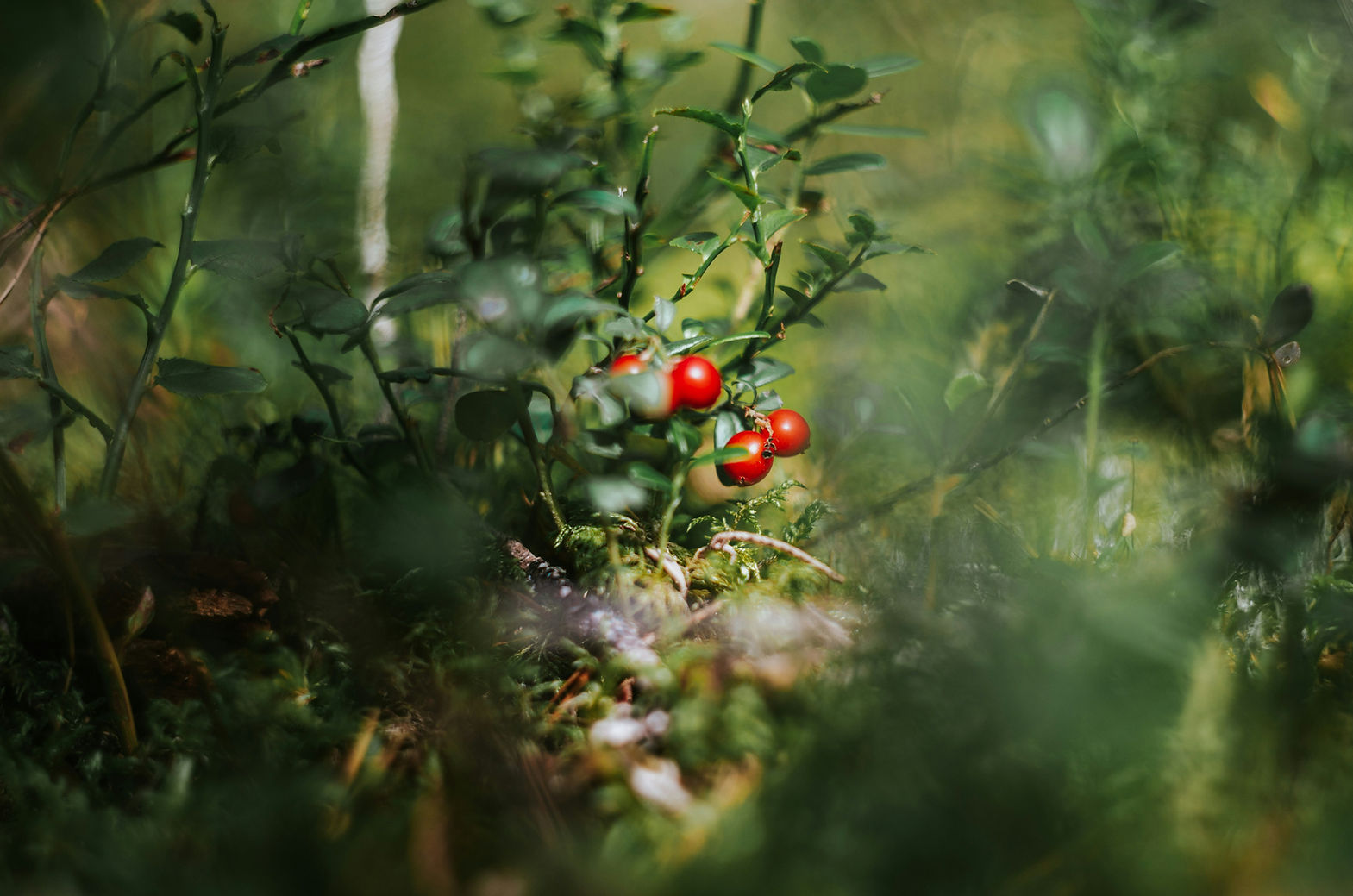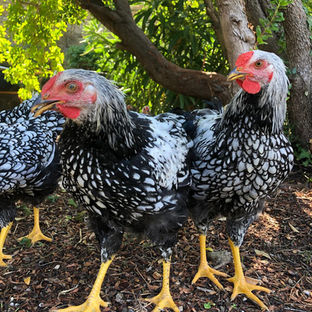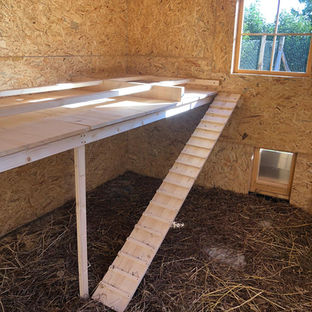CHICKENS & COOPS
INSPIRA Permaculture
Chickens have a special role in permaculture farms. They are an “element” that plays many functions around the farm. Firstly, they lay fabulous and delicious free-range eggs for us (we are vegetarian). Secondly, they keep the top soil layer of the areas they roam aired, and thirdly, they fertilize the soil with their hourly poop "donations". In our farm, they roam freely and stay generally some 100 meters radius from their coop, so that makes for a lot of ground, especially if we also consider that they walk about 1.5km per day. Fourthly, in that same area, insects, arachnids and other crawlers and creepers are kept in a healthy check. Lastly, they provide us with feathers (we don't take them, just pick what they drop naturally), and of course with a free sunrise waker!


BUGS FOR CHICKENS, MORE FOOD FOR US
Chickens are a natural and effective “pest control method" in gardens and even in food forests. Their foraging behavior, including scratching and pecking for bugs, creepers and slugs, reduces pest populations, which in excess would quickly be damaging the yield of the garden.
Chickens mix leaf litter, minimizing pests’ hideout places, and in combination with the chickens’ sharp eyesight they are quick and effective at catching them. This natural behavior is a true win-win for farmers in general, as it reduces the need for other pest control methods, promoting a healthier and more natural garden environment.

CHICKENS AIRATE SOIL
Beyond pest control, chickens’ foraging also contributes to soil health through their scratching. They mix leaf litter and organic matter, thus accelerating decomposition. Furthermore, the scratching helps to keep the top layer of the soil aired by turning it over and mixing it with the decomposing dry leaves and plants. This activity also pushes air into the ground, improving aeration to plant roots and allowing them to grow better, not to mention enhancing the water movement.



NATURAL SOIL FERTILIZER
Chicken droppings also acts as a natural fertilizer, enriching the soil with essential nutrients.
Their poops are very rich in nitrogen, which is crucial for plant growth.
And did you know that chickens poop once every hour? So, whatever you do, you will have plenty of nitrogen rich fertilizer consistently being delivered directly on the ground and mixed in too.

WHY CHOOSE OLD BREEDS?
After hundreds of years of domestication and lately even full-blown exploitation for their eggs and meat, chickens have been bread and almost over-bread to mainly serve either of the above mentioned products. However, as we explained, in more traditional and regenerative farming practices, the chickens are chosen to fulfill a much richer and complex role in the garden or farm ecosystem. Particularly interesting is their foraging, pest control, aeration and fertilization of the soil. The eggs are a nice little extra. Older breads are typically more sturdy, and harder workers on the ground. The one breed we chose is Wyandotte, and old North American breed. They exist in different variations of colors, always with a very interesting pattern on their feathers.



CHICKENS IN PARADISE
Integrating chickens into a permaculture system requires careful planning to ensure a harmonious environment for the flock, while maximizing their benefits to the entire system. The chickens' natural behaviors contribute to a balanced ecosystem. Their presence reduces the need for external inputs like pesticides and fertilizers, making the garden more sustainable.
Chickens offer many benefits to a garden ecosystem and are a very welcome initial animal husbandry in permaculture projects.
However, one needs to make sure to provide them with the right environment, and to keep them safe and healthy.
In permaculture, chickens are generally free-range and are kept in flocks of about 10-20 chickens per rooster. They can be kept in an enclosed area or leave them free to roam around the farm.
It is fair to say, that chickens have many predators in a farm, especially if close to a forest, as is our case. Everything from foxes and badgers to hawks and owls will be eyeing free range chickens. Quality fencing some areas is the best way to prevent chickens from becoming some other animal’s dinner. Also it’s important to keep the chickens indoors in their coop or barn at night.

"THE CHICK-INN"
FIX CHICKEN COOP & RUN
A chicken coop is a fun project to make. There are many requirements that need to be met, not only by law, but also to ensure the health and wellbeing of the chickens. Important elements include, among others:
-
A good air circulation, without causing drafts, especially in winter.
-
A good perching space, all at the same level to not reinforce hierarchy amongst them.
-
A quiet space where they can have some peace
-
Nesting boxes to lay their eggs. We included a top lid to get the eggs without being seen.
-
Containers for food, grit and water, ideally lifted from the ground to avoid rodents and other animals getting into their food or water.
-
A box of sand or dry soil to clean their feathers.
-
An automatic door that opens and closes with the sunlight.
-
Good isolation in walls and roof, and windows with nets that allow for air and light flow
-
A pre-room where we keep their food, and which we can access without disturbing them.
-
The Chick-Inn includes a large run area that is fenced with a small-mesh metal-wire net, and a couple of shaded areas. Next is to add quite some plants and herbs in there, including Lavender, Rosemary, Dandelion, Chamomile, Peppermint, Fennel, Marjoram, Marigold, Parsley, and perhaps even some Cucumber or Zucchini plants grow-up onto the fence.



THE "CHICK-MOBILE" COOP FOR IN THE FOOD FOREST
A mobile chicken coop or at least a mobile chicken run is ideal for food forests and orchards that are further away on the land of the farm. With the re-purposed roulotte or trailer we now call the "Chick-Mobile", the chickens have a coop inside that has all the features of the fixed coop, except for the separate storage room.
One fun creative weekend with the help of my dear artist and muralist friend Katrin Loglio, we spray-painted the old roulotte our kind neighbors gave us. Around the entire Chick-Mobile you'll find portrayed key features and animals from the farm: the chickens, the lizards and geckos, the spiders and butterflies, the caterpillars and cactuses, owls and bats, the olive & fruit trees, and even the future cat we hope to get soon.
Once the Food Forest is in place, we and the new chicken flock is here, we will deploy the "Chick-Mobile" around the farm.

CONTINUOUS LEARNING
Keeping chickens is undoubtedly a continuous learning, but a good basis, reading, visiting courses, and just observation and getting to know your flock is crucial for a healthy and long lasting relationship with chickens.

A GALLERY OF IMAGES




















